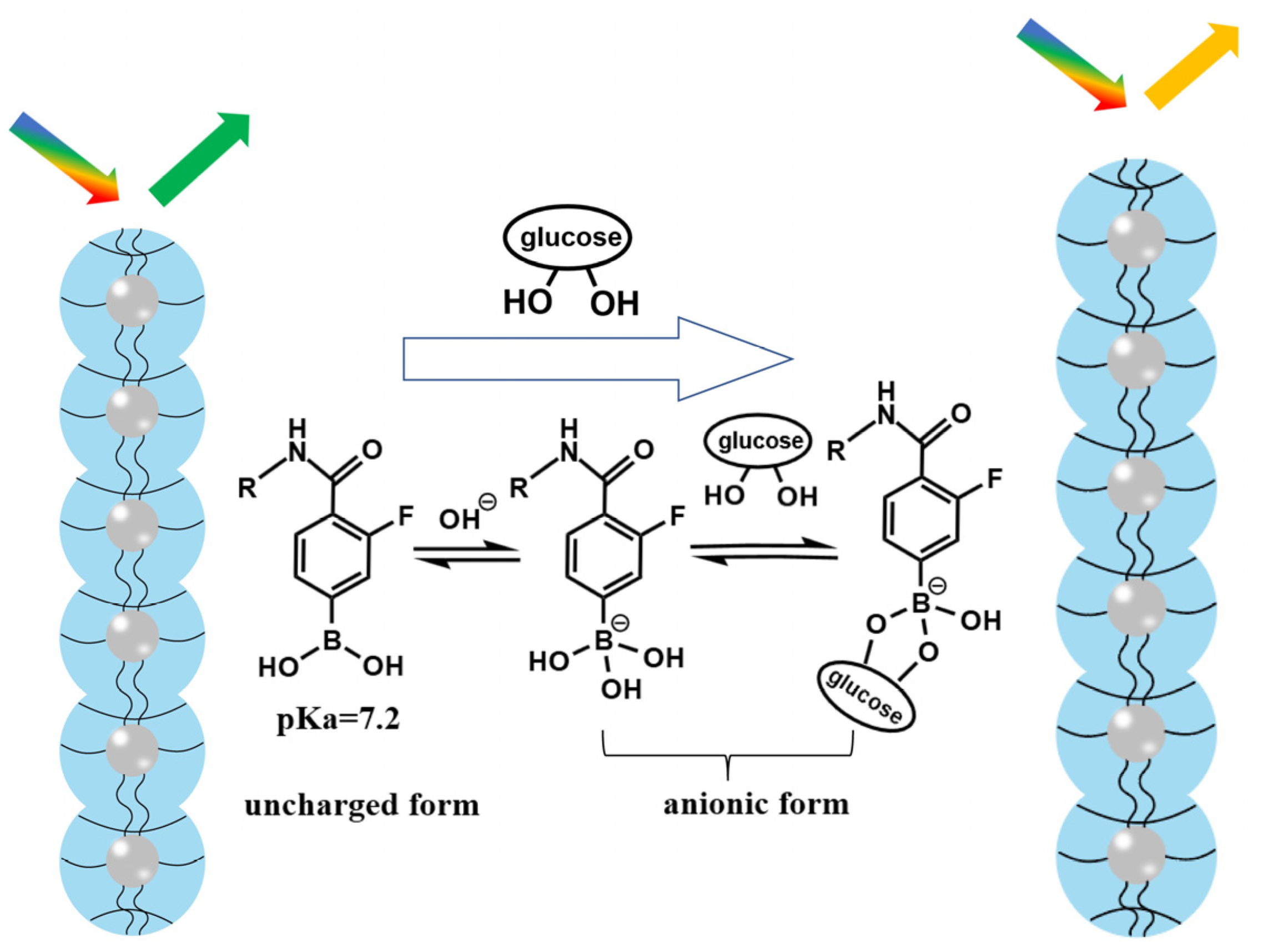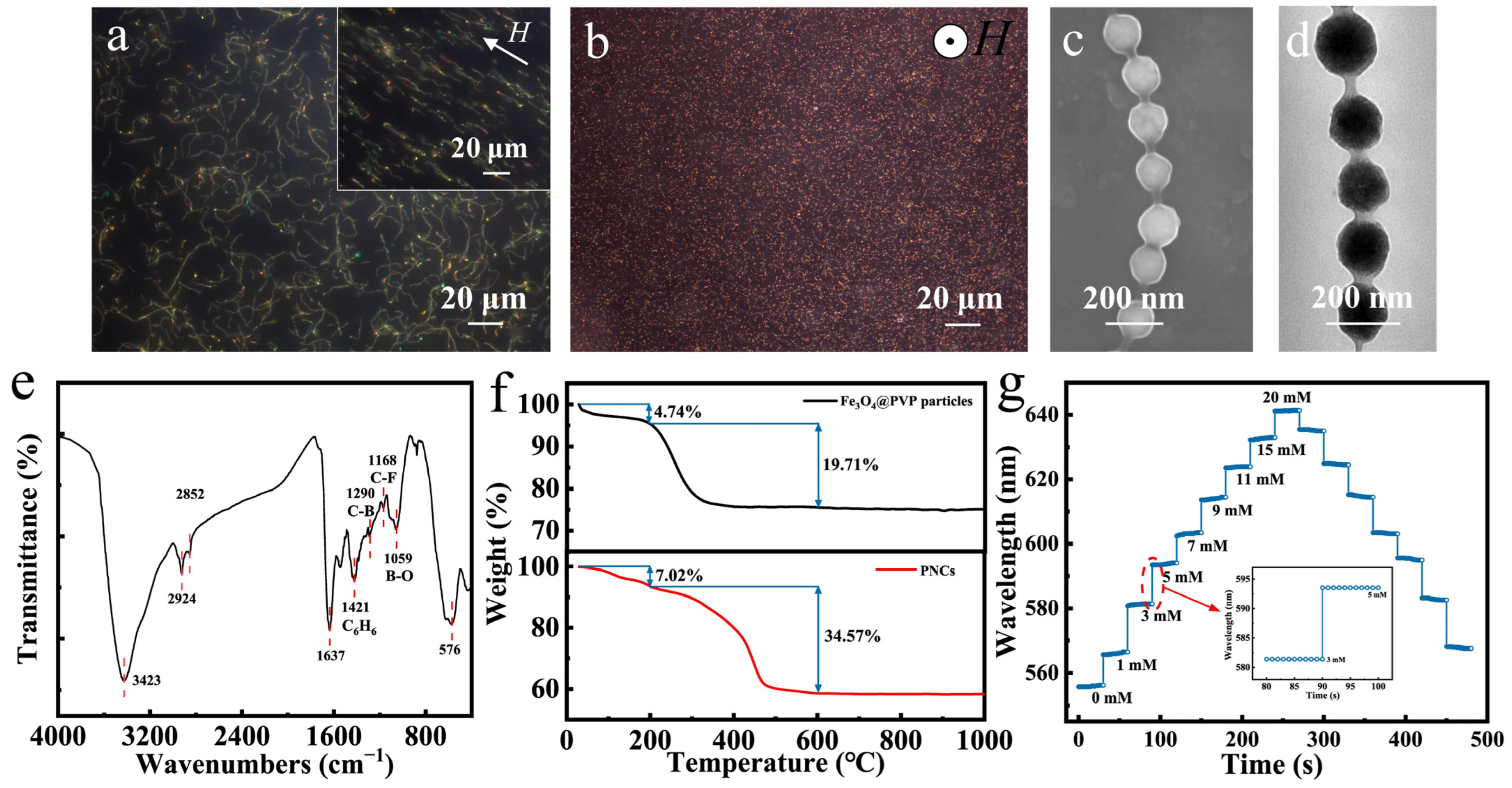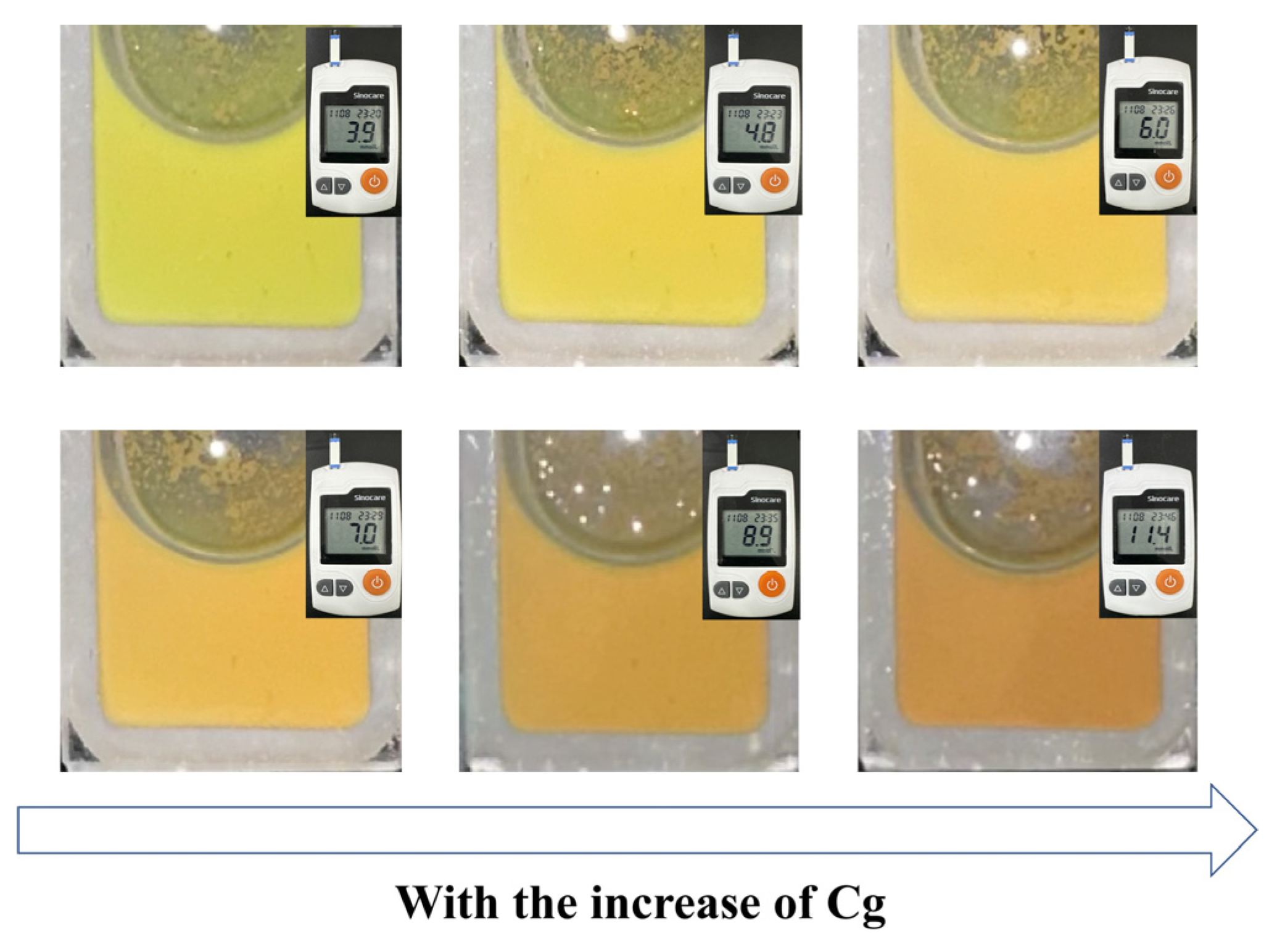Photonic Nanochains for Continuous Glucose Monitoring in Physiological Environment
Abstract
1. Introduction
2. Materials and Methods
2.1. Materials
2.2. Preparation of the Prepolymerization Solution
2.3. Preparation of Fe3O4@(PVP-PAA)@poly(AFPBA-co-HEAAm) PNCs
2.4. Characterizations
2.5. Optical Properties
2.6. Calculation of the Content of Each Component in the Fe3O4@(PVP-PAA)@poly(AFPBA-co-HEAAm) PNCs
2.7. Calculation of Hydrogen Bond Energies
3. Results and Discussion
3.1. Formation and Response Mechanism of Fe3O4@(PVP-PAA)@poly(AFPBA-co-HEAAm) PNCs after the Addition of PAA and AFPBA
3.2. Characterization and Glucose-Sensing Performances of Typical Fe3O4@(PVP-PAA)@poly(AFPBA-co-HEAAm) PNCs
3.3. Explanation and Verification of the Mechanism of PAA-Induced PNCs Formation
3.4. Effects of Preparation Conditions and pH on the Dispersibility and Glucose-Sensing Performances of the Fe3O4@(PVP-PAA)@poly(AFPBA-co-HEAAm) PNCs
3.5. Application of Fe3O4@(PVP-PAA)@poly(AFPBA-co-HEAAm) PNCs to Detect Cg in Artificial Serum
4. Conclusions
Supplementary Materials
Author Contributions
Funding
Data Availability Statement
Conflicts of Interest
References
- Lee, Y.B.; Han, K.; Kim, B.; Lee, S.E.; Jun, J.E.; Ahn, J.; Kim, G.; Jin, S.M.; Kim, J.H. Risk of early mortality and cardiovascular disease in type 1 diabetes: A comparison with type 2 diabetes, a nationwide study. Cardiovasc. Diabetol. 2019, 18, 157. [Google Scholar] [CrossRef] [PubMed]
- Ong, K.L.; Stafford, L.K.; McLaughlin, S.A.; Boyko, E.J.; Vollset, S.E.; Smith, A.E.; Dalton, B.E.; Duprey, J.; Cruz, J.A.; Hagins, H.; et al. Global, regional, and national burden of diabetes from 1990 to 2021, with projections of prevalence to 2050: A systematic analysis for the Global Burden of Disease Study 2021. Lancet 2023, 402, 203–234. [Google Scholar] [CrossRef] [PubMed]
- Sun, H.; Saeedi, P.; Karuranga, S.; Pinkepank, M.; Ogurtsova, K.; Duncan, B.B.; Stein, C.; Basit, A.; Chan, J.C.N.; Mbanya, J.C.; et al. IDF Diabetes Atlas: Global, regional and country-level diabetes prevalence estimates for 2021 and projections for 2045. Diabetes Res. Clin. Pract. 2023, 183, 109119. [Google Scholar] [CrossRef] [PubMed]
- Kong, A.P.S.; Lim, S.; Yoo, S.H.; Ji, L.N.; Chen, L.M.; Bao, Y.Q.; Yeoh, E.; Chan, S.P.; Wang, C.Y.; Mohan, V.; et al. Asia-Pacific consensus recommendations for application of continuous glucose monitoring in diabetes management. Diabetes Res. Clin. Pract. 2023, 201, 110718. [Google Scholar] [CrossRef]
- Govindaraj, M.; Srivastava, A.; Muthukumaran, M.K.; Tsai, P.C.; Lin, Y.C.; Raja, B.K.; Rajendran, J.; Ponnusamy, V.K.; Selvi, J.A. Current advancements and prospects of enzymatic and non-enzymatic electrochemical glucose sensors. Int. J. Biol. Macromol. 2023, 253, 126680. [Google Scholar] [CrossRef] [PubMed]
- Adeel, M.; Rahman, M.M.; Caligiuri, I.; Canzonieri, V.; Rizzolio, F.; Daniele, S. Recent advances of electrochemical and optical enzyme-free glucose sensors operating at physiological conditions. Biosens. Bioelectron. 2020, 165, 112331. [Google Scholar] [CrossRef]
- Dincer, C.; Bruch, R.; Costa-Rama, E.; Fernández-Abedul, M.T.; Merkoçi, A.; Manz, A.; Urban, G.A.; Güder, F. Disposable Sensors in Diagnostics, Food, and Environmental Monitoring. Adv. Mater. 2019, 31, e1806739. [Google Scholar] [CrossRef] [PubMed]
- Xue, Y.; Thalmayer, A.S.; Zeising, S.; Fischer, G.; Lübke, M. Commercial and Scientific Solutions for Blood Glucose Monitoring—A Review. Sensors 2022, 22, 425. [Google Scholar] [CrossRef] [PubMed]
- Mitsou, E.; Xenakis, A.; Zoumpanioti, M. Oxidation Catalysis by Enzymes in Microemulsions. Catalysts 2017, 7, 52. [Google Scholar] [CrossRef]
- Wang, Y.Z.; Ma, R.; Li, S.G.; Gong, M.B.; Yao, B.; Bai, Y.G.; Gu, J.G. An alkaline and surfactant-tolerant lipase from Trichoderma lentiforme ACCC30425 with high application potential in the detergent industry. AMB Express 2018, 8, 95. [Google Scholar] [CrossRef]
- Toit, H.d.; Lorenzo, M.D.J.E.A. Glucose oxidase directly immobilized onto highly porous gold electrodes for sensing and fuel cell applications. Electrochim. Acta 2014, 138, 86–92. [Google Scholar] [CrossRef]
- Wang, C.; Gao, N.; Gao, Z.; Li, R.; Wang, Y.; Gong, W. An Effective Non-Enzymatic Glucose Biosensor Based on Nanostructured CuxO/Cu Electrodes Synthesized in Situ by Copper Anodization. Eur. J. Inorg. Chem. 2023, 26, e202200640. [Google Scholar] [CrossRef]
- Wang, P. Highly Sensitive Enzyme-Free Electrochemical Sensor based on Ni(OH)2/C Composite for the Detection of Blood Glucose. Int. J. Electrochem. Sci. 2022, 17, 221010. [Google Scholar] [CrossRef]
- Wang, M.; You, Z.H.; Liu, F.; Jiang, L.Y. Recent Advances in Materials for Enzyme-free Electrochemical Glucose Sensors. Sens. Mater. 2023, 35, 1001–1022. [Google Scholar] [CrossRef]
- Si, P.; Huang, Y.J.; Wang, T.H.; Ma, J.M. Nanomaterials for electrochemical non-enzymatic glucose biosensors. RSC Adv. 2013, 3, 3487–3502. [Google Scholar] [CrossRef]
- Sreejaya, M.M.; Pillai, V.M.; Ayesha, A.; Baby, M.; Bera, M.; Gangopadhyay, M. Mechanistic analysis of viscosity-sensitive fluorescent probes for applications in diabetes detection. J. Mater. Chem. B 2024, 12, 2917–2937. [Google Scholar] [CrossRef]
- Kumari, A.; Vyas, V.; Kumar, S. Synthesis, characterization, and applications of gold nanoparticles in development of plasmonic optical fiber-based sensors. Nanotechnology 2023, 34, 042001. [Google Scholar] [CrossRef]
- Yuan, H.; Ji, W.; Chu, S.; Qian, S.; Wang, F.; Masson, J.-F.; Han, X.; Peng, W. Fiber-optic surface plasmon resonance glucose sensor enhanced with phenylboronic acid modified Au nanoparticles. Biosens. Bioelectron. 2018, 117, 637–643. [Google Scholar] [CrossRef] [PubMed]
- Steiner, M.-S.; Duerkop, A.; Wolfbeis, O.S. Optical methods for sensing glucose. Chem. Soc. Rev. 2011, 40, 4805–4839. [Google Scholar] [CrossRef]
- Garzón, V.; Pinacho, D.G.; Bustos, R.H.; Garzón, G.; Bustamante, S. Optical Biosensors for Therapeutic Drug Monitoring. Biosensors 2019, 9, 132. [Google Scholar] [CrossRef]
- van Enter, B.J.; von Hauff, E. Challenges and perspectives in continuous glucose monitoring. Chem. Commun. 2018, 54, 5032–5045. [Google Scholar] [CrossRef]
- Jin, X.; Cai, A.; Xu, T.; Zhang, X. Artificial intelligence biosensors for continuous glucose monitoring. Interdiscip. Mater. 2023, 2, 290–307. [Google Scholar] [CrossRef]
- Elshaarani, T.; Yu, H.; Wang, L.; Zainul, A.; Ullah, R.S.; Haroon, M.; Khan, R.U.; Fahad, S.; Khan, A.; Nazir, A.; et al. Synthesis of hydrogel-bearing phenylboronic acid moieties and their applications in glucose sensing and insulin delivery. J. Mater. Chem. B 2018, 6, 3831–3854. [Google Scholar] [CrossRef]
- Wen, X.; Liu, Y.; Liu, Q.; Chen, Z.; Hu, X.; Xu, C.; Chen, H.; Xing, M.; Qu, H.; Zhang, M. Glucose sensing based on hydrogel grating incorporating phenylboronic acid groups. Opt. Express 2022, 30, 47541–47552. [Google Scholar] [CrossRef]
- Tang, W.; Chen, C.J.P. Hydrogel-Based Colloidal Photonic Crystal Devices for Glucose Sensing. Polymers 2020, 12, 625. [Google Scholar] [CrossRef]
- Wu, Q.; Wang, L.; Yu, H.; Wang, J.; Chen, Z. Organization of Glucose-Responsive Systems and Their Properties. Chem. Rev. 2011, 111, 7855–7875. [Google Scholar] [CrossRef]
- Shen, P.; Zhang, Y.; Cai, Z.; Liu, R.; Xu, X.; Li, R.; Wang, J.-J.; Dean, Y. Three-dimensional/two-dimensional photonic crystal hydrogels for biosensing. J. Mater. Chem. B 2021, 9, 5840–5857. [Google Scholar] [CrossRef]
- Galisteo-López, J.F.; Ibisate, M.; Sapienza, R.; Froufe-Pérez, L.S.; Blanco, A.; López, C. Self-assembled photonic structures. Adv. Mater. 2011, 23, 30–69. [Google Scholar] [CrossRef]
- Xue, F.; Meng, Z.H.; Wang, F.Y.; Wang, Q.H.; Xue, M.; Xu, Z.B. A 2-D photonic crystal hydrogel for selective sensing of glucose. J. Mater. Chem. A 2014, 2, 9559–9565. [Google Scholar] [CrossRef]
- von Freymann, G.; Kitaev, V.; Lotschz, B.V.; Ozin, G.A. Bottom-up assembly of photonic crystals. Chem. Soc. Rev. 2013, 42, 2528–2554. [Google Scholar] [CrossRef]
- Biswas, U.; Nayak, C.; Rakshit, J.K. Fabrication techniques and applications of two-dimensional photonic crystal: History and the present status. Opt. Eng. 2023, 62, 010901. [Google Scholar] [CrossRef]
- Zhang, C.J.; Losego, M.D.; Braun, P.V. Hydrogel-Based Glucose Sensors: Effects of Phenylboronic Acid Chemical Structure on Response. Chem. Mat. 2013, 25, 3239–3250. [Google Scholar] [CrossRef]
- Cai, J.Y.; Luo, W.; Pan, J.J.; Li, G.; Pu, Y.Y.; Si, L.Y.; Shi, G.P.; Shao, Y.X.; Ma, H.R.; Guan, J.G. Glucose-Sensing Photonic Nanochain Probes with Color Change in Seconds. Adv. Sci. 2022, 9, 2105239. [Google Scholar] [CrossRef] [PubMed]
- Li, L.; Yu, Z.; Liu, J.; Yang, M.; Shi, G.; Feng, Z.; Luo, W.; Ma, H.; Guan, J.; Mou, F. Swarming Responsive Photonic Nanorobots for Motile-Targeting Microenvironmental Mapping and Mapping-Guided Photothermal Treatment. Nano-Micro Lett. 2023, 15, 141. [Google Scholar] [CrossRef] [PubMed]
- Luo, W.; Cui, Q.; Fang, K.; Chen, K.; Ma, H.; Guan, J. Responsive Hydrogel-based Photonic Nanochains for Microenvironment Sensing and Imaging in Real Time and High Resolution. Nano Lett. 2020, 20, 803–811. [Google Scholar] [CrossRef] [PubMed]
- Liu, Y.; Fan, Q.; Zhu, G.; Shi, G.; Ma, H.; Li, W.; Wu, T.; Chen, J.; Yin, Y.; Guan, J.J.M.h. A dual responsive photonic liquid for independent modulation of color brightness and hue. Mater. Horiz. 2021, 87, 2032–2040. [Google Scholar] [CrossRef] [PubMed]
- Matsumoto, A.; Ishii, T.; Nishida, J.; Matsumoto, H.; Kataoka, K.; Miyahara, Y. A Synthetic Approach Toward a Self-Regulated Insulin Delivery System. Angew. Chem. Int. Ed. 2012, 51, 2124–2128. [Google Scholar] [CrossRef] [PubMed]
- Li, D.; Chen, Y.; Liu, Z. Boronate affinity materials for separation and molecular recognition: Structure, properties and applications. Chem. Soc. Rev. 2015, 44, 8097–8123. [Google Scholar] [CrossRef] [PubMed]
- Guo, Z.; Liu, H.; Shi, Z.; Lin, L.; Li, Y.; Wang, M.; Pan, G.; Lei, Y.; Xue, L. Responsive hydrogel-based microneedle dressing for diabetic wound healing. J. Mater. Chem. B 2022, 10, 3501–3511. [Google Scholar] [CrossRef]
- Luo, W.; Ma, H.; Mou, F.; Zhu, M.; Yan, J.; Guan, J. Steric-Repulsion-Based Magnetically Responsive Photonic Crystals. Adv. Mater. 2014, 26, 1058–1064. [Google Scholar] [CrossRef]
- Elsherif, M.; Hassan, M.U.; Yetisen, A.K.; Butt, H. Wearable Contact Lens Biosensors for Continuous Glucose Monitoring Using Smartphones. Acs Nano 2018, 12, 5452–5462. [Google Scholar] [CrossRef] [PubMed]
- Emamian, S.; Lu, T.; Kruse, H.; Emamian, H. Exploring Nature and Predicting Strength of Hydrogen Bonds: A Correlation Analysis Between Atoms-in-Molecules Descriptors, Binding Energies, and Energy Components of Symmetry-Adapted Perturbation Theory. J. Comput. Chem. 2019, 40, 2868–2881. [Google Scholar] [CrossRef] [PubMed]
- Frisch, M.J.; Schlegel, H.B.; Scuseria, G.E.; Robb, M.A.; Cheeseman, J.R.; Scalmani, G.; Barone, V.; Mennucci, B.; Petersson, G.A.; Nakatsuji, H.; et al. Gaussian 09, Revision D.01; Gaussian, Inc.: Wallingford, CT, USA, 2009. [Google Scholar]
- Zhao, Y.; Truhlar, D.G. The M06 suite of density functionals for main group thermochemistry, thermochemical kinetics, noncovalent interactions, excited states, and transition elements: Two new functionals and systematic testing of four M06 functionals and 12 other functionals. Theor. Chem. Acc. 2008, 119, 525. [Google Scholar] [CrossRef]
- Weigend, F.; Ahlrichs, R. Balanced basis sets of split valence, triple zeta valence and quadruple zeta valence quality for H to Rn: Design and assessment of accuracy. Phys. Chem. Chem. Phys. 2005, 7, 3297–3305. [Google Scholar] [CrossRef] [PubMed]
- Lu, T.; Chen, F. Multiwfn: A multifunctional wavefunction analyzer. J. Comput. Chem. 2012, 33, 580–592. [Google Scholar] [CrossRef] [PubMed]
- Kikuchi, A.; Suzuki, K.; Okabayashi, O.; Hoshino, H.; Kataoka, K.; Sakurai, Y.; Okano, T. Glucose-Sensing Electrode Coated with Polymer Complex Gel Containing Phenylboronic Acid. Anal. Chem. 1996, 68, 823–828. [Google Scholar] [CrossRef] [PubMed]
- Matsumoto, A.; Ikeda, S.; Harada, A.; Kataoka, K. Glucose-Responsive Polymer Bearing a Novel Phenylborate Derivative as a Glucose-Sensing Moiety Operating at Physiological pH Conditions. Biomacromolecules 2003, 4, 1410–1416. [Google Scholar] [CrossRef] [PubMed]
- Lee, Y.-J.; Pruzinsky, S.A.; Braun, P.V. Glucose-Sensitive Inverse Opal Hydrogels: Analysis of Optical Diffraction Response. Langmuir 2004, 20, 3096–3106. [Google Scholar] [CrossRef]
- Hong, X.; Peng, Y.; Bai, J.; Ning, B.; Liu, Y.; Zhou, Z.; Gao, Z. A Novel Opal Closest-Packing Photonic Crystal for Naked-Eye Glucose Detection. Small 2014, 10, 1308–1313. [Google Scholar] [CrossRef]
- Ayyub, O.B.; Ibrahim, M.B.; Briber, R.M.; Kofinas, P. Self-assembled block copolymer photonic crystal for selective fructose detection. Biosens. Bioelectron 2013, 46, 124–129. [Google Scholar] [CrossRef]
- Shi, T.; Kou, D.; Gao, L.; Xue, Y.; Zhang, S.; Ma, W. One-Dimensional Responsive Photonic Crystals Assembled by Polymer Nanogels and TiO2 Nanoparticles for Rapid Detection of Glucose. ACS Appl. Nano Mater 2024, 7, 3116–3128. [Google Scholar] [CrossRef]









Disclaimer/Publisher’s Note: The statements, opinions and data contained in all publications are solely those of the individual author(s) and contributor(s) and not of MDPI and/or the editor(s). MDPI and/or the editor(s) disclaim responsibility for any injury to people or property resulting from any ideas, methods, instructions or products referred to in the content. |
© 2024 by the authors. Licensee MDPI, Basel, Switzerland. This article is an open access article distributed under the terms and conditions of the Creative Commons Attribution (CC BY) license (https://creativecommons.org/licenses/by/4.0/).
Share and Cite
Shi, G.; Si, L.; Cai, J.; Jiang, H.; Liu, Y.; Luo, W.; Ma, H.; Guan, J. Photonic Nanochains for Continuous Glucose Monitoring in Physiological Environment. Nanomaterials 2024, 14, 964. https://doi.org/10.3390/nano14110964
Shi G, Si L, Cai J, Jiang H, Liu Y, Luo W, Ma H, Guan J. Photonic Nanochains for Continuous Glucose Monitoring in Physiological Environment. Nanomaterials. 2024; 14(11):964. https://doi.org/10.3390/nano14110964
Chicago/Turabian StyleShi, Gongpu, Luying Si, Jinyang Cai, Hao Jiang, Yun Liu, Wei Luo, Huiru Ma, and Jianguo Guan. 2024. "Photonic Nanochains for Continuous Glucose Monitoring in Physiological Environment" Nanomaterials 14, no. 11: 964. https://doi.org/10.3390/nano14110964
APA StyleShi, G., Si, L., Cai, J., Jiang, H., Liu, Y., Luo, W., Ma, H., & Guan, J. (2024). Photonic Nanochains for Continuous Glucose Monitoring in Physiological Environment. Nanomaterials, 14(11), 964. https://doi.org/10.3390/nano14110964





